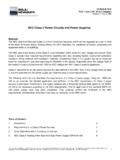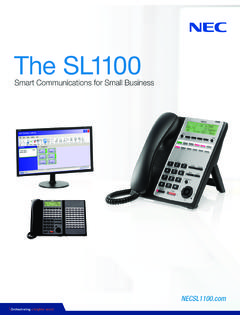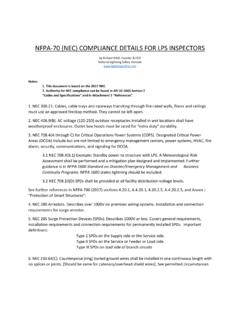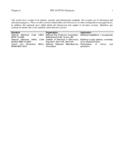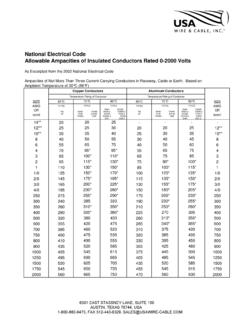Transcription of NEC-2 Manual, Part III: User’s Guide
1 WDBN version 9/24/96 p. 1 of 131. NEC- 2 manual , part III: user 's Guide Microsoft Word/Macintosh formatted binary document (WDBN). version, including all Figures, ready for printing, and incorporating many corrections, of the html version of the NEC- 2 manual at < ~richesop/nec/>. Table of Contents Section Page LIST OF ILLUSTRATIONS 3. Preface 4. Disclaimer for the Web and Microsoft Word Versions 5. Abstract 5. I. INTRODUCTION 6. II. STRUCTURE MODELING GUIDELINES 7. 1. Wire Modeling 7. 2. Surface Modeling 10. 3. Modeling Structures Over Ground 13. III. PROGRAM INPUT 15. 1. Comment Cards (CM, CE) 15. 2. Structure Geometry Input Cards 16. + Wire Arc Specification (GA) 16. + End Geometry Input (GE) 17. + Read Numerical Green's Function File (GF) 19. + Helix/Spiral Specification (GH) 20. + Coordinate Transformation (GM) 21. + Generate Cylindrical Structure (GR) 23. + Scale Structure Dimensions (GS) 25. + Wire Specification (GW) 26. + Reflection in Coordinate Planes (GX) 28. + Surface Patch (SP) 30.
2 + Multiple Patch Surface (SM) 34. + Examples of Structure Geometry Data 36. - Rhombic Antenna - No Symmetry 36. - Rhombic Antenna - Plane Symmetry, 2 Planes 37. - Rhombic Antenna - Plane Symmetry, 1 Plane 38. - Two Coaxial Rings 39. CCC'. s Word/Mac WDBN version of NEC-2 user '. s Guide from < ~richesop/nec/> Page 2 of 131. - Linear Antenna over a Wire Grid Plate 40. - Cylinder with Attached Wires 41. 3. Program Control Cards 43. + Maximum Coupling Calculation (CP) 45. + Extended Thin-Wire Kernel (EK) 46. + End of Run (EN) 47. + Excitation (EX) 48. + Frequency (FR) 52. + Additional Ground Parameters (GD) 53. + Ground Parameters (GN) 55. + Interaction Approximation Range (KH) 57. + Loading (LD) 58. + Near Fields (NE, NH) 60. + Networks (NT) 62. + Next Structure (NX) 65. + Print Control for Charge on Wires (PQ) 66. + Page Title / Print Control for Current on Wires (PT) 67. + Radiation Pattern (RP) 69. + Transmission Line (TL) 73. + Write NGF File (WG) 75. + Execute (XQ) 76. 4. SOMNEC Input for Sommerfeld/Norton Ground Method 77.
3 5. The Numerical Green's Function Option 78. IV. NEC OUTPUT 80. o Examples 1 through 4 82. + Example 1, Center-Fed Linear Antenna: Model, Results 83. + Example 2, Center-Fed Linear Antenna: Model, Results 86. + Example 3, Vert. Antenna Over Ground: Model, Results 91. + Example 4, T Ant. on Box over Perfect Ground: Model, Results 96. o Example 5: Log-Periodic Antenna 100. + Model, Results 100, 101. o Example 6: Cylinder with Attached Wires 106. + Model, Results 106. o Examples 7 & 8: Scattering by a Wire / Aircraft 114. + Model, Results 114. o Example 9: Scattering by a Sphere (n/a). CCC'. s Word/Mac WDBN version of NEC-2 user '. s Guide from < ~richesop/nec/> Page 3 of 131. o Example 10: Monopole on Radial Wire Ground Screen (n/a). V. EXECUTION TIME 118. o Benchmark Times on Various Platforms 118. o TEST299 Benchmark Input Data File 121. VI. DIFFERENCES BETWEEN NEC-2 , NEC-1, AND AMP2 122. VII. FILE STORAGE REQUIREMENTS 123. VIII. ERROR MESSAGES 125. REFERENCES 130. Contributors to the Web Edition of this manual 131.
4 LIST OF ILLUSTRATIONS. Figure Page 1 Patch Position and Orientation 10. 2 Connection of a Wire to a Surface Patch 11. 3 Patch Models for a Sphere 12. 4 Bistatic RCS of a Sphere with ka = (a) Uniform segmentation 12. (b) Variable segmentation 13. 5 Surface Patch Option (5a, 5b, 5c, 5d) 31, 32, 32, 32. 6 Rectangular Surface Covered by Multiple Patches 34. 7 Rhombic Antenna - No Symmetry 36. 8 Rhombic Antenna - 2 Planes of Symmetry 37. 9 Rhombic Antenna - 1 Plane of Symmetry 38. 10 Coaxial Rings 39. 11 Wire Grid Plate and Dipole 40. 12 Development of Surface Model for Cylinder with Attached Wires 41. 13 Segmentation of Cylinder for Wires Connected to End and Side 42. 14 Specification of Incident Wave 50. 15 Orientation of Current Element 50. 16 Parameters for a Second Ground Medium 53. 17 Segment Loaded by Means of a 2-Port Network 63. 18 Coordinates for Radiated Field 70. 19 Stick Model of Aircraft 114. CCC'. s Word/Mac WDBN version of NEC-2 user '. s Guide from < ~richesop/nec/> Page 4 of 131.
5 Preface The Numerical Electromagnetics Code (NEC) has been developed at the Lawrence Livermore Laboratory, Livermore, California, under the sponsorship of the Naval Ocean Systems Center and the Air Force Weapons Laboratory. It is an advanced version of the Antenna Modeling Program (AMP) developed in the early 1970's by MBAssociates for the Naval Research Laboratory, Naval Ship Engineering Center, Army ECOM/Communications Systems, Army Strategic Communications Command, and Rome Air Development Center under Office of Naval Research Contract N00014-71-C-0187. The present version of NEC is the result of efforts by G. J. Burke and A. J. Poggio of Lawrence Livermore Laboratory. The documentation for NEC consists of three volumes: part I: NEC Program Description - Theory part II: NEC Program Description - Code part III: NEC user 's Guide The documentation has been prepared by using the AMP documents as foundations and by modifying those as needed. In some cases this led to minor changes in the original documents while in many cases major modifications were required.
6 Over the years many individuals have been contributors to AMP and NEC and are acknowledged here as follows: * R. W. Adams * J. N. Brittingham * G. J. Burke * F. J. Deadrick * K. K. Hazard * D. L. Knepp * D. L. Lager * R. J. Lytle * E. K. Miller * J. B. Morton * G. M. Pjerrou * A. J. Poggio * E. S. Selden The support for the development of NEC-2 at the Lawrence Livermore Laboratory has been provided by the Naval Ocean Systems Center under MIPR-N0095376MP. Cognizant individuals under whom this project was carried out include: * J. Rockway * J. Logan Previous development of NEC also included the support of the Air Force Weapons Laboratory (Project Order 76-090) and was monitored by J. Castillo and TSgt. H. Goodwin. Work was performed under the auspices of the U. S. Department of Energy by the Lawrence Livermore National Laboratory under contract No. W-7405-Eng-48. Reference to a company or product name does not imply approval or recommendation of the product by the University of California or the U.
7 S. Department of Energy to the exclusion of others that may be suitable. CCC'. s Word/Mac WDBN version of NEC-2 user '. s Guide from < ~richesop/nec/> Page 5 of 131. Disclaimer for the Web and Microsoft Word Versions This manual was originally prepared as an account of work sponsored by the United States Government. Neither the United States nor the United States Department of Energy, nor any of their employees, nor any of their contractors, subcontractors, or their employees, makes any warranty, express or implied, or assumes any legal liability or responsibility for the accuracy, completeness or usefulness of any information, apparatus, product or process disclosed, or represents that its use would not infringe privately-owned rights. The Web (html) and Microsoft Word (WDBN) versions of this manual were derived from the original, printed version by uncompensated volunteers, through optical scanning and automatic character recognition (OCR), retyping, reformatting and other editing (see page 131).
8 These processes have inevitably introduced errors and omissions, for which the United States Government, Lawrence Liver - more National Laboratory and University of California have no responsibility. No assurance is made by anyone as to the completeness, accuracy, or suitability for any purpose of any version of this manual . Users should be particularly alert for errors of the sort that occur frequently with OCR, , missed decimal points and minus signs; confusion of the numeral 1 , the lower-case letter l , and the upper-case letter I ; misalignment of columns in card images due to miscounting of spaces; and incorrect word substi - tution by automatic spell-checking programs. Abstract The Numerical Electromagnetics code ( NEC-2 ) is a computer code for analyzing the electromagnetic response of an arbitrary structure consisting of wires and surfaces in free space or over a ground plane. The analysis is accomplished by the numerical solution of integral equations for induced currents. The excitation may be an incident plane wave or a voltage source on a wire, while the output may include current and charge density, electric or magnetic field in the vicinity of the structure, and radiated fields.
9 NEC-2 includes several features not contained in NEC-1, including an accurate method for modeling grounds, based on the Sommerfeld integrals, and an option to modify a structure without repeating the complete solution. This manual contains instruction for use of the Code, including preparation of input data and interpretation of the output. Examples are included that show typical input and output and illustrate many of the special options available in NEC-2 [text missing?] covering the equations and details of the coding, are referenced. CCC'. s Word/Mac WDBN version of NEC-2 user '. s Guide from < ~richesop/nec/> Page 6 of 131. Section I - I N T R O D U C T I O N. The Numerical Electromagnetics Code ( NEC-2 ) is a user -oriented computer code for analysis of the electromagnetic response of antennas and other metal structures. It is built around the numerical solution of integral equations for the currents induced on the structure by sources or incident fields. This approach avoids many of the simplifying assumptions required by other solution methods and provides a highly accurate and versatile tool for electromagnetic analysis.
10 The code combines an integral equation for smooth surfaces with one specialized for wires to provide for convenient and accurate modeling of a wide range of structures. A model may include nonradiating networks and transmission lines connecting parts of the structure, perfect or imperfect conductors, and lumped element loading. A structure may also be modeled over a ground plane that may be either a perfect or imperfect conductor. The excitation may be either voltage sources on the structure or an incident plane wave of linear or elliptic polarization. The output may include induced currents and charges, near electric or magnetic fields, and radiated fields. Hence, the program is suited to either antenna analysis or scattering and EMP studies. The integral equation approach is best suited to structures with dimensions up to several wavelengths. Although there is no theoretical size limit, the numerical solution requires a matrix equation of increasing order as the structure size is increased relative to wavelength.

